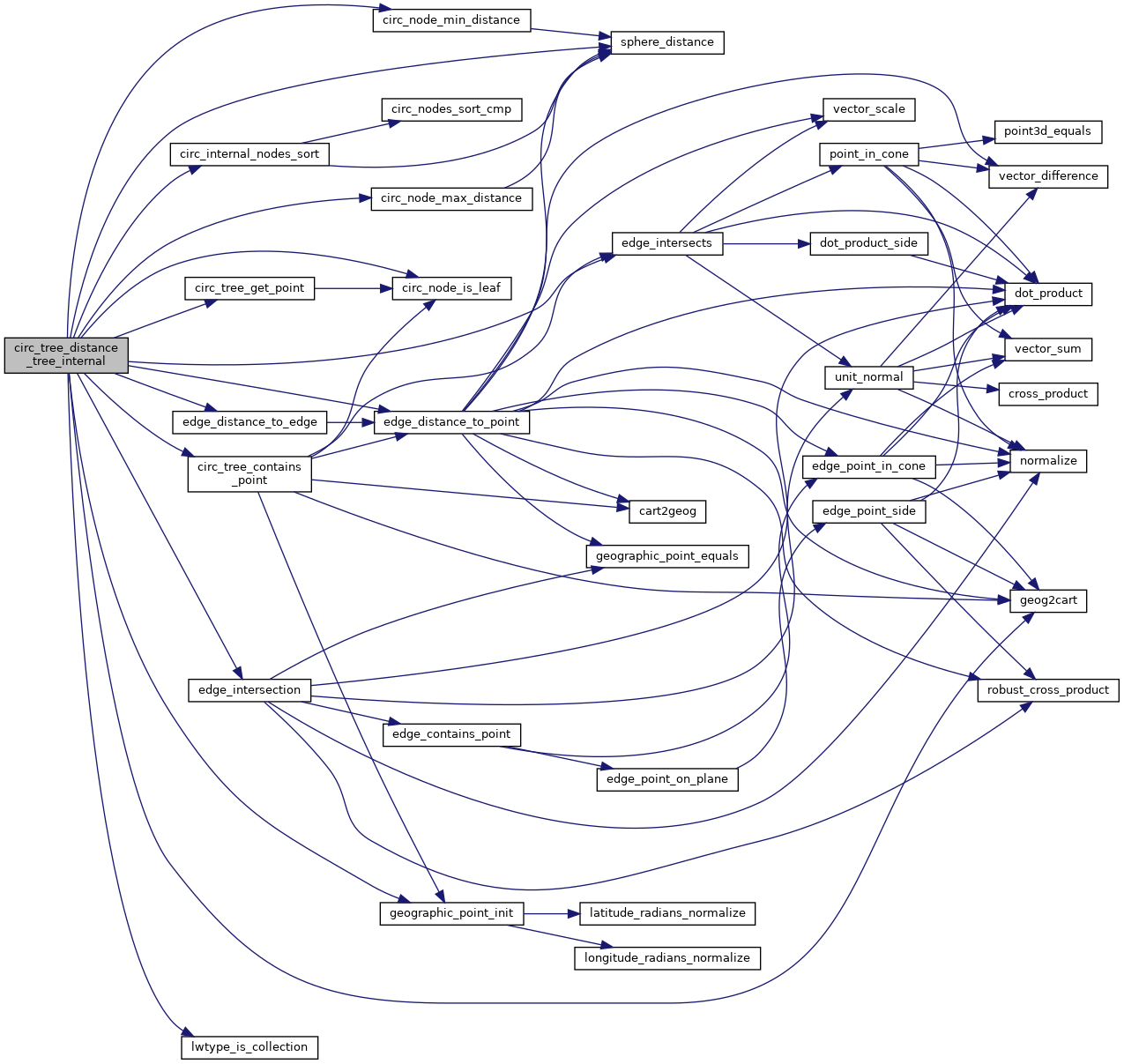◆ circ_tree_distance_tree_internal()
|
static |
Definition at line 678 of file lwgeodetic_tree.c.
684 LWDEBUGF(4, "entered, min_dist=%.8g max_dist=%.8g, type1=%d, type2=%d", *min_dist, *max_dist, n1->geom_type, n2->geom_type);
826 d = circ_tree_distance_tree_internal(n1->nodes[i], n2, threshold, min_dist, max_dist, closest1, closest2);
835 d = circ_tree_distance_tree_internal(n1, n2->nodes[i], threshold, min_dist, max_dist, closest1, closest2);
844 d = circ_tree_distance_tree_internal(n1->nodes[i], n2, threshold, min_dist, max_dist, closest1, closest2);
853 d = circ_tree_distance_tree_internal(n1, n2->nodes[i], threshold, min_dist, max_dist, closest1, closest2);
int lwtype_is_collection(uint8_t type)
Determine whether a type number is a collection or not.
Definition: lwgeom.c:1087
void geographic_point_init(double lon, double lat, GEOGRAPHIC_POINT *g)
Initialize a geographic point.
Definition: lwgeodetic.c:180
double sphere_distance(const GEOGRAPHIC_POINT *s, const GEOGRAPHIC_POINT *e)
Given two points on a unit sphere, calculate their distance apart in radians.
Definition: lwgeodetic.c:948
int edge_intersection(const GEOGRAPHIC_EDGE *e1, const GEOGRAPHIC_EDGE *e2, GEOGRAPHIC_POINT *g)
Returns true if an intersection can be calculated, and places it in *g.
Definition: lwgeodetic.c:1127
uint32_t edge_intersects(const POINT3D *A1, const POINT3D *A2, const POINT3D *B1, const POINT3D *B2)
Returns non-zero if edges A and B interact.
Definition: lwgeodetic.c:3541
double edge_distance_to_point(const GEOGRAPHIC_EDGE *e, const GEOGRAPHIC_POINT *gp, GEOGRAPHIC_POINT *closest)
Definition: lwgeodetic.c:1218
void geog2cart(const GEOGRAPHIC_POINT *g, POINT3D *p)
Convert spherical coordinates to cartesian coordinates on unit sphere.
Definition: lwgeodetic.c:404
double edge_distance_to_edge(const GEOGRAPHIC_EDGE *e1, const GEOGRAPHIC_EDGE *e2, GEOGRAPHIC_POINT *closest1, GEOGRAPHIC_POINT *closest2)
Calculate the distance between two edges.
Definition: lwgeodetic.c:1269
int circ_tree_get_point(const CIRC_NODE *node, POINT2D *pt)
Returns a POINT2D that is a vertex of the input shape.
Definition: lwgeodetic_tree.c:461
static double circ_node_max_distance(const CIRC_NODE *n1, const CIRC_NODE *n2)
Definition: lwgeodetic_tree.c:603
static double circ_tree_distance_tree_internal(const CIRC_NODE *n1, const CIRC_NODE *n2, double threshold, double *min_dist, double *max_dist, GEOGRAPHIC_POINT *closest1, GEOGRAPHIC_POINT *closest2)
Definition: lwgeodetic_tree.c:678
static int circ_node_is_leaf(const CIRC_NODE *node)
Internal nodes have their point references set to NULL.
Definition: lwgeodetic_tree.c:40
static void circ_internal_nodes_sort(CIRC_NODE **nodes, uint32_t num_nodes, const CIRC_NODE *target_node)
Definition: lwgeodetic_tree.c:653
static double circ_node_min_distance(const CIRC_NODE *n1, const CIRC_NODE *n2)
Definition: lwgeodetic_tree.c:590
int circ_tree_contains_point(const CIRC_NODE *node, const POINT2D *pt, const POINT2D *pt_outside, int level, int *on_boundary)
Walk the tree and count intersections between the stab line and the edges.
Definition: lwgeodetic_tree.c:495
Definition: liblwgeom.h:375
Definition: liblwgeom.h:387
References circ_internal_nodes_sort(), circ_node_is_leaf(), circ_node_max_distance(), circ_node_min_distance(), circ_tree_contains_point(), circ_tree_get_point(), sort_node::d, edge_distance_to_edge(), edge_distance_to_point(), edge_intersection(), edge_intersects(), circ_node::edge_num, GEOGRAPHIC_EDGE::end, FP_MIN, geog2cart(), geographic_point_init(), circ_node::geom_type, LWDEBUG, LWDEBUGF, lwtype_is_collection(), circ_node::nodes, circ_node::num_nodes, circ_node::p1, circ_node::p2, POLYGONTYPE, circ_node::pt_outside, sphere_distance(), GEOGRAPHIC_EDGE::start, POINT2D::x, and POINT2D::y.
Referenced by circ_tree_distance_tree().
Here is the call graph for this function:

Here is the caller graph for this function:
